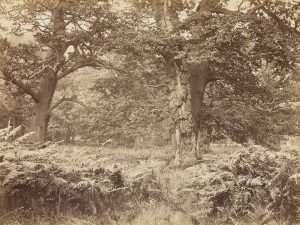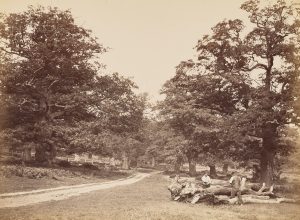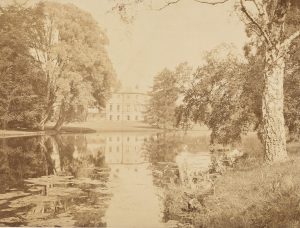April 22, 2021, by Kathryn Steenson
Forestry and Photography
In the 11th century, Sherwood Forest covered 20% to 25% of Nottinghamshire and after the Norman invasion of 1066, was designated a Royal Forest and hunting ground. Charles I (1600-1649) was the last monarch to hunt there, and by the 18th century, large swathes had been gifted or sold to aristocratic families.
Amongst those noblemen was the Earl of Kingston-upon-Hull who bought land at Perlethorpe and Bilhaugh from the Crown to create Thoresby Park and Hall. Eventually the estate was inherited by the Earls Manvers, and it was to Sydney William Herbert Pierrepont the 3rd Earl Manvers that this album of photographs was presented.
Sherwood Forest and Thoresby Park, dedicated by permission to the Rt. Hon. Earl Manvers, containing photographs by Alfred W. Cox, 1866 (Ref: Ma 7/Ph 1) contains photographs showing forest scenes and a couple of images of the mansion at Thoresby. Despite being 160 years old, they are in beautiful condition and show wonderful detail. They were evidently taken on a sunny summer day, probably several days, and carefully mounted in a red leather binding. Most are landscape, but a few have captured people at work within the forest.
Sherwood Forest has never been totally wild. Many of the birch and oak trees are between 500 and 1000 years old, and have been carefully managed for much of their lifespan. The forest was a valuable resource for wood and timber required for building, which required regular coppicing and pollarding (cutting back trees to promote new growth). Twigs and brushwood were sold as domestic fuel sources, or used to make charcoal. As the photos show, there is plenty of space, and in fact the woodland is interspersed with large areas of open heath and grassland. Creatures that were hunted, such as pheasant and deer, prefer a mixture of open ground, where food is plentiful, and woodland, for cover. The forest was also a major source of food for livestock, with cattle and sheep grazing the woodland pasture, and pigs being fed the acorns collected each autumn.
The album is dated 1866 but the photos may have been taken slightly earlier, based on the photos of Thoresby Hall. The building in the photograph was the second Hall, having been completely rebuilt by the architect John Carr and completed in 1772 after the first Hall was destroyed by fire. In 1864 3rd Earl Manvers had the second house demolished as its low situation next to the lake had often been criticised as unhealthy.
In many of the photos, cart tracks or lanes are visible. Obviously with lots of people living and working in the forest, there would need to be roads, but it’s no accident that they appear in the photos. In the 1860s, landscape photography would have required cumbersome and expensive equipment. It’s highly likely that the photographer would have travelled on horse and cart, which means some of the wilder areas of the forest would have been inaccessible.
That photographer was Alfred W Cox. Born in Nottingham, he started his career in the 1850s as an artist and selling art supplies and frames. In 1856 he opened his first photographic studio and quickly gained a reputation for excellent work, hence his work for Earl Manvers, in 1863 was based at 11 St James Street, Nottingham. In 1876 his wife Ellen and their children took over the business.
This album has been digitised and the images are available to view by appointment in the Reading Room. If you’re interested in the history of Sherwood Forest, then we have an online exhibition, and for more information about the collections we hold, see the website, follow us on Twitter @mssUNiNott, or subscribe to the magazine Discover.
No comments yet, fill out a comment to be the first





Leave a Reply